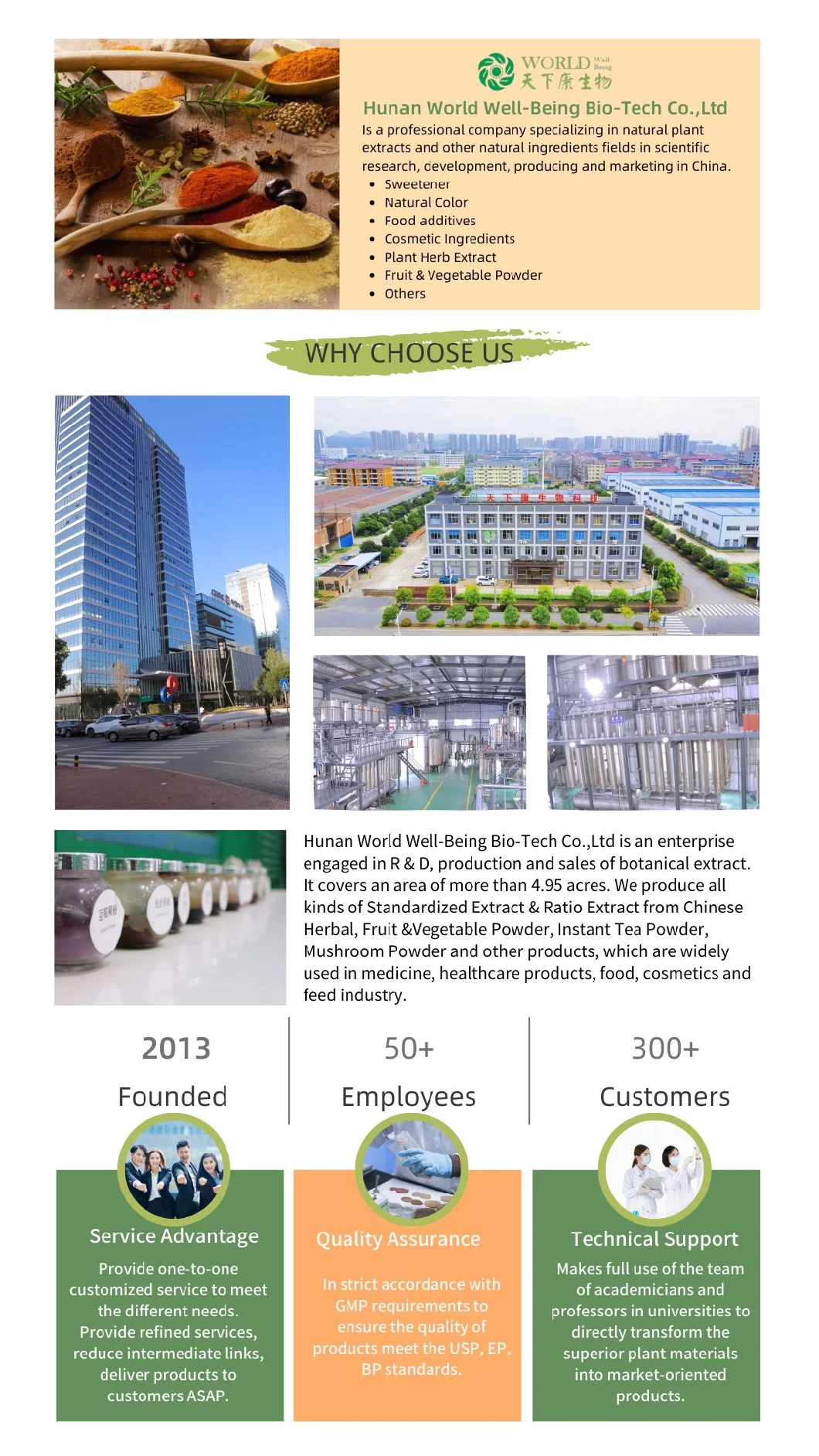
World Well-Being Biotech ISO&FDA Certified OEM Manufacturer 10%-95% Mogrosides 10%-50% Mogroside V Monk Fruit Extract Luohan Guo Extract
Product Description
Description
Basic Info
| Product Name | Luohan Guo Extract |
| Latin Name | Momordica Grosvenori Swingle |
| Used Part | Fruit |
| Appearance | Light Yellow to White Fine Powder |
| Payment | T/T in Advance |
| Shelf Life | 24 Months |
| Delivery Time | 3-5 Working Days |
| Free Sample | Available |
| Transport Package | 25kg/Drum |
| Specification | 10%-95% Mogrosides 10%-50% Mogroside V |
| Origin | Hunan, China |
| Production Capacity | 8t/Month |
Product Description
| Product Name | Luohan Guo Extract |
| Botanical Name1 | Momordica grosvenori Swingle |
| Part Used | Fruit |
| Appearance | Light Yellow to White Powder |
| Specification | 4:1 10:1Juice Powder10%-95% Mogrosides 10%-50% Mogroside V |
| Storage Period | 24 Months |
| Package | 1kg/bag 25kg/drum |
| Storage Conditions | Store in cool and dry places. Keep away from strong light and heat. |
Description Monk fruit is a robust, perennial, dioecious climbing herb with fusiform to sub-globose roots. The plant grows 2 to 5 meters long and climbs by axillary bifid tendrils. Leaves are ovate cordate to hastate to almost triangular 8-15 cm long by 3-12 cm wide with 2-7 cm long, acute to acuminate apex deeply cordate-emarginate at base. Female inflorescence form in axillary clusters which is solitary, 5-merous with persistent reflexed sepals and yellowish, lanceolate-acuminate thin petals. An ovary is inferior, oblong-ovoid 8-11 mm long by 4-5 mm wide rounded at the base and trilocualr with numerous ovules in six rows. Male inflorescence is racemose and arise singulary from leaf axils. An epicarp is thin but hard with three doubled locules each with two rows of seeds surrounded by brownish grey pulp that dried to light soft material. Seeds are flattened, broadly oval or ovate, light brownish grey and 15-18 mm long, 10-12 mm broad. Plant A vine attains length of 3-5 meters climbing over other plant by means of tendrils which twine around anything they touch. Leaves Leaves are narrow and heart shaped about 10-20 cm long. Flowers Unisexual ones are dioecious; peduncle, pedicel, petals and sepals are pubescent and covered with glandular hairs. Male flowers are axillary and 5-7 are arranged in racemes. Female flowers are solitary in leaf axils. The flowers blooms from June to August and fruiting period is from August to October. Fruits Fruit is round, obovate or oblong, 5-7 cm in diameter, smooth, yellow-brownish or green-brownish in color which contains striations from the fruit stem end of furrows with hard but thin skin covered by fine hairs. Skin is dark reddish brown when young and green or pubescent when mature. Health Benefits 1. Lowers inflammation Monk fruit has mogrosides which helps to protect tissues in the body from damage caused by free radicals which is a major source of inflammation. It contradicts inflammatory response caused by sugar consumption. The study shows antioxidant effect to provide protection for insuli secreting cells of pancreas and improves insuli response. It offers anti-inflammatory properties through regulation of blood sugar. 2. Cancer prevention Cancer is caused due to accumulation of DNA damage caused by free radicals. It optimizes antioxidant systems which lowers DNA damage which occurs and lowers the chances of cancer. Moreover, the same mechanism helps the body to manage existing cancers. Mogrosides found in Monk fruit is studied for its antioxidant properties which show some promising cancer related research demonstrating anti-cancer effects. The study shows that mogroside V helps to inhibit rapid progression of pancreatic cancer cells in mice. 3. Prevents Seasonal Allergy Cells within bodies are responsible for initiating inflammatory responses when required. The study conducted in mice with monk fruit extract for 4 weeks shows significant reduction in histamine-response to allergens occurred. The same effect was not observed with a single dose. This shows that regular use of monk fruit sweetener provides some allergy relief. 4. Anti-Microbial activity Monk fruit has anti-microbial properties which maintain proper bacterial balance. The leaves and fruit extracts have shown to inhibit candida, streptococcus and bacteria responsible for gum disease in mouth. The sugar to chemical sweeteners such as sucralose or aspartame does not provide same effect as these sweeteners have bad effect on health of gut microbiome and contributes to unwanted microbial growth. 5. Anti-Fibrotic Pulmonary fibrosis is a condition in which tissue of lungs becomes scarred and rigid and interferes with ability to breath properly and extract oxygen from the air. Research has observed mogroside IIIE isolated from monk fruit as anti-fibrotic compound with promising results. Study has shown that mogroside IIIE acts as anti-fibrotic by controlling inflammation and helps to regulate cellular matrix deposition. 6. Combat obesity Eliminating sugar from diet results healthier metabolism and body composition. Study showed the influence of monk fruit, mogrol on fat accumulation and found that it inhibits differentiation of pre-adipocytes into mature adipocytes. It lowers the body's ability to promote overall fat mass. 7. Protection from Heart Disease Study shows the effect of monk fruit extract on diabetic mice which revealed that mogrosides have capacity to promote blood sugar response and also control the side effects associated to high cholesterol. 8. Combat Infections Antibiotics are used for treating bacterial infections. Natural antimicrobial agents are best option to slow ongoing surge of antibiotic resistance. Monk fruit inhibits growth of certain bacteria especially oral bacteria which causes tooth decay and periodontal disease. | |




Prev: Best Luo Han Guo Monk Fruit Extract Sweeten Food Additives
Next: Natural Skin Whitening Raw Material Apple Extract CAS No. 60-82-2
Our Contact
Send now






